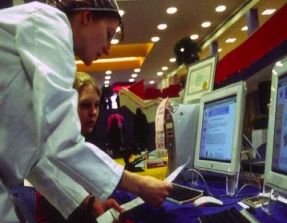|
Notable artists have referenced Massumi and Varela in their explorations of perceptual experience. Diane Gromala's work entitled The MeatBook, for example, explores what she terms the "visceral register," which "insists upon taking into account the varying levels of awareness and intensity of bodily forms of knowledge." The book, made of meat, holds proximity sensors that cause the book to quiver when viewers come near it. When the pages are turned, the book reacts with animal sounds and indistinct odors. Her project entitled The Living Book allows users to see their physical surroundings while engaging with "three-dimensional mixed realities that appear on their headsets." [4] The Whisper Project by Thecla Schiphorst, Susan Kozel, et al. [5] developed garments that collect physiological data from the wearers and then transmit the data to other wearers. At the Ciberart Bilbao Conference in May 2004, Kozel asked her audience to see these networks as extensions of the body -- cyberpathways as extensions of neurological system, muscles, and skin. [6]
Varela's and Massumi's work suggests that embodied hybrid experience does not stop at the sensorial, but also operates in larger cultural contexts. Referring to embodiment, Varela writes: "This unique, concrete knowledge, its historicity and context, is not 'noise' that occludes the brighter pattern to be captured in its true essence, an abstraction, nor is it a step toward something else: it is how we arrive and where we stay." [7] And so, the same phenomenology that supports the importance of embodied sensory experience implies social/cultural connection between the body and its environment (virtual or otherwise).
While it can be argued that all representation is perceived in the body and has sociopolitical implications, Simon Penny claims that "interaction renders conventional critiques of representation inadequate." [8] In his article entitled "Representation, Enaction, and the Ethics of Simulation," Penny expresses concern about "the fact that bodily behavior is intertwined with the formation of representation. It is the ongoing interaction between these representations and the embodied behavior of the user that makes such images more than images." [9] Penny particularly expresses concern about uses of virtual reality in military training, for example. In a response to Penny's essay, Eugene Thacker agrees that "technologies of simulation are also social technologies because they are hardware and software systems that model, induce, and articulate particular types of actions and behaviors." [10] Foucault might have seen VR as an ideal training medium for "docile bodies." [11] Rather than being the quintessential postmodern medium allowing for a transcendence of race/gender, death of the author, exploration of multiple subjectivities, and proliferation of new expressions of democracy, cybertechnologies perhaps more often reinforce power structures with strong economic interests. At Matel's web site [12], for example, girls can play a game in which they design their own Barbie doll, selecting from a limited range of skin tones and lip colors, which become overlaid on idealized westernized features. On one level, girls can play the game for entertainment. On another level, they are designing a doll that they can buy, so the game is also an act of shopping. On yet another level, they are being trained to select prescribed gender attributes in acts of simulated eugenics. In virtual environments, if images are indeed "more than images," then new technologies call for new understanding of representation and aesthetic experience that looks at these differences. Alongside of the artificial intelligence research that strives to make machines more human and virtual reality more realistic, perhaps we need sociopolitical intelligence as well, which would strive to make virtual representation more mindful of the sociopolitical body. Or, perhaps when artificial intelligence becomes more advanced, it will allow for more reflexive and socially responsible / engaged behavior than the first-person shooter and military training environments currently do. Meanwhile, Penny believes that "the phenomenon of computational entities responding to their environments implies a new aesthetic field that we might call 'procedural aesthetics' or an 'aesthetics of automated behavior.' [13]
Natalie Bookchin (new media artist) and Jacqueline Stevens (political theorist) seem to be exploring such possibilities in a project called AgoraXchange, a site where the public can provide input into the development of the aesthetics and rules of a game that will re-imagine current world order (tag line: "Make the Game. Change the World."). The resulting game, Agora, is scheduled to launch in June 2005. Creative Capital Channel reports that Bookchin's "project aims include helping articulate creative, democratic possibilities in considering ways to exist within a rapidly changing world governed by corporate interests." Bookchin states: "Thus far, large scale online game worlds have either recapitulated the status quo or relied on fantasy and escapist scenarios. With Agora, our aim is to offer a feasible alternative model for the real world and to witness, through the creative participation of its inhabitants, what that world would look like -- what alliances, affinities, and conflicts might arise." [14] This project represents an interesting approach to developing virtual reality aesthetics and architecture -- allowing the players to interact, not only in the game itself but in making the rules and creating the environments. AgoraXchange creates space for reflection rather than merely training participants to habitually react to given stimuli, as first-person shooter games and military training VR arguably do.
When considering sociopolitical aspects of the body in virtual reality, we might also ask ourselves about the implications of operating in an environment that is largely based on deception. The very phenomenology of simulation is a matter of tricking the biological body into believing that a digital feedback loop is a real-life stimulus-and-response dynamic based on a "real" situation. When we go to see a film (or even when we watch TV), we are willing to suspend disbelief, but when we enter into virtual reality, we are willing to believe. And there is the illusion that the user is generating the experience, even though we know that our actions are limited to the architecture of the computer program.
Our willingness to believe in the computer environment, without questioning, seems to be challenged by Josh Skeen's artwork entitled LoveMaker. [15] LoveMaker "automates the writing of loveletters based on a profile of the user's selections of a specified gender." When your lover has been composited (based on your selection of models), the computer begins to compose your love letter for you. The result is humorous language in strategic configurations that draw attention to limitations of computer programs and our willingness to play along anyway ("Thoughts of you boogyed in my sensitive spirit, but just whispering 'yacht pony' in your ear isn't going to prove my love to you, is it?"). Skeen says that he created the project after reading about hypnotic language and neurolinguistic programming, as well as theories of Gregory Bateson and Noam Chomsky. The project raises important questions: If we consider a love letter to be one of the most personal, intimate forms of communication possible (and yet one that can become a medium of deception itself -- for example, in cases when someone writes a love letter for a friend), then to what extent can a computer "help" and still technically allow the user to be the author? Is it possible for a computer to engage in anything so personal, especially if we consider knowledge to be embodied and to have sexual and ethnic specificity? Certainly identity must be considered to be something "more than images." Can a computer pretend to have a human identity, given identity's embodied nature? Can another user in an RPG, for that matter? If a computer could pull off a love letter, would it be possible to fall in love with your software? Skeen explains the background of his project:
I was enthralled by these slightly sinister, tactical approaches to communication, where someone operates a language that isn't perceived by the target yet affects them in a transformative way. My feelings about programming languages at the time were that they're similar to hypnotic languages for their users -- via words determined by the perception of perhaps unregarded or previously unobserved signal responses to stimulus, real changes occur in the user's mind from the resulting returned signal (feedback loop the programmer has established with the end user).
Of course, the very title of the project (LoveMaker) implies that love can be manufactured by the computer.
Some of the most interesting artwork challenging our notions of common ground between virtual and real-life interaction is that which combines cybertechnologies with live performance. The cyberfeminist art collective subRosa combines live performances with cybertechnologies to bring awareness of biotech issues. For example, at Bowling Green State University, in a performance entitled US Grade AAA Premium Eggs [16], subRosa members dressed as corporate representatives guiding students through an Internet survey designed to "Calculate Your Net Worth on the Flesh Market" (see screenshot).

Faith Wilding, a pioneer of the women's art movement and member of subRosa, reports that some students have became so upset by the group's presence as "trade show representatives" at these performances that they have complained to university administrators, only to find that the very issues that are upsetting them are the issues the group is trying to illuminate -- namely, corporate commodification of the body, without accountability to the public. Audience reaction seems to suggest that students are critically engaged with the performances. subRosa follows up with critical engagement about biotech issues -- for example, by holding convocations with the students or providing literature.
The group's performances also push issues about what can or cannot be believed in cyberspace and in real space, and the relative importance of real-life interaction in our constructions of reality. In some ways, we might see subRosa's performance as terrible deception. And if so, we have to ask ourselves about how the embodied performance version per se of the Internet deception seems so much more terrible than a clever, promotional web site that might be more easily entertained or dismissed. Obviously, the answer lies in the fact that, when we cross over, out of cyberspace and into real space, there is a full sensory experience in human interaction that creates a qualitative difference in how the information is shaped and experienced. Unlike an Internet presentation or even an Internet "identity," real-life interaction furthermore carries ethical accountability (it's different to be lied to or exploited by a person than by a machine). Overall, the project motivates us to ask: If this performance seems to be a profound deception, what about the virtual and real-life deceptions perpetrated by the corporations (e.g., in the medical community) that are marketing biotech for profit, with little or no ethical accountability to the bodies they alter? Is that somehow "honest" or "real" in comparison?
 A related project entitled YOU-GEN-A-CHIX (YOUGenics2: Exploring the Social Implications of Genetic Technologies) [17], performed at Southwest Missouri State University, used the premium eggs survey but also offered taste testing of a "subRosa-made superior chicken biscuit purported to enhance student smartness and improve memory." subRosa then conducted videotape interviews of students discussing their opinions of reproductive technologies. subRosa's "Cultures of Eugenics" pamphlet addressed the question "Why are women like chickens," and "linked human Assisted Reproductive Technologies with the genetic engineering of chickens, pharming, cloning, and eugenic breeding." A related project entitled YOU-GEN-A-CHIX (YOUGenics2: Exploring the Social Implications of Genetic Technologies) [17], performed at Southwest Missouri State University, used the premium eggs survey but also offered taste testing of a "subRosa-made superior chicken biscuit purported to enhance student smartness and improve memory." subRosa then conducted videotape interviews of students discussing their opinions of reproductive technologies. subRosa's "Cultures of Eugenics" pamphlet addressed the question "Why are women like chickens," and "linked human Assisted Reproductive Technologies with the genetic engineering of chickens, pharming, cloning, and eugenic breeding."
Art practices that include crossovers from cyber experience to live performance (including those of subRosa, Critical Art Ensemble and others) seem to provide a unique look at the "crossover" from screen to real space and the qualitative differences we experience in each space. They suggest that getting at the problems of the aesthetic experience in artistic virtual environments might mean looking beyond issues of representation in terms of perception, cognition, and signification, and grappling with the nature of corporeality and materiality in lived interaction -- the possibility that what flesh and blood (or bricks and mortar, or paint and canvas) mean to us (sociopolitically and otherwise) might be fundamentally different than what virtual "presence" can mean.
References
[1] Marie-Laure Ryan, Narrative as Virtual Reality: Immersion and Interactivity in Literature and Electronic Media (Johns Hopkins University Press: Baltimore, 2001), p. 354
[2] Francisco J. Varela, "The Reenchantment of the Concrete" in Jonathan Crary and Sanford Kwinter (Eds.), Incorporations: Zone 6 (Zone Books: New York, 1992), p. 320
[3] Brian Massumi (143)
Brian Massumi, "On The Superiority of the Analog" in Parables for the Virtual: Movement, Affect, Sensation. Post-Contemporary Interventions (Duke University Press, 2002)
[4] Diane Gromala, MeatBook, Georgia Institute of Technology.
Diane Gromala, The Living Book, Georgia Institute of Technology; project description: http://www.lcc.gatech.edu/%7Egromala/livingbook/;
Diane Gromala, "Re-enervating Flesh: Organic Matter and Visceral Sensations of BioTechnoogies," paper presented at College Art Association Conference, Feb. 16, 2005
[5] Thecla Schiphorst, Susan Kozel, et al. <between bodies> / Whisper, Ciberart Festival Bilbao (International Festival of New Technologies, Art & Communication), Bilbao, Spain, 2004. Project Description: http://whisper.surrey.sfu.ca/
[6] Susan Kozel, "Bodies and Nets," presentation at Ciberart Bilbao Conference (International Festival of New Technologies, Art & Communication), Bilbao, Spain, 2004
[7] Ibid. [2], p. 320
[8] Simon Penny, "Representation, Enaction, and the Ethics of Simulation" in Noah Wardrip-Fruin and Pat Harrigan (Eds.), First Person: New Media as Story, Performance, and Game (The MIT Press: Cambridge, MA, 2004), p. 83
[9] Ibid., p. 83
[10] Eugene Thacker,. Response to "Representation, Enaction, and the Ethics of Simulation" in Noah Wardrip-Fruin and Pat Harrigan (Eds.), First Person: New Media as Story, Performance, and Game (The MIT Press: Cambridge, MA, 2004), pp. 73-75
[11] Michel Foucault, Discipline and Punish: The Birth of the Prison (Random House: New York, 1975 / 1995)
[12] Barbie.com, http://www.barbie.com and http://barbie.everythinggirl.com/Activities/Fashion_Fun/MyDesign/look.asp; June 8, 2005
[13] Ibid. [8]
[14] Natalie Bookchin, AgoraXchange, http://www.agoraxchange.net;
Natalie Bookchin, "Natalie Bookchin: AGORA," Creative Capital Channel, http://channel.creative-capital.org/project_63.html; Natalie Bookchin and Jacqueline Stevens, "AgoraXchange: Make the Game. Change the World," http://www.agoraxchange.net/index.php?page=279#279
[15] Josh Skeen, LoveMaker; http://www.joshskeen.com/lovemaker.html; Rhizome ArtBase, http://rhizome.org/object.rhiz?32364;
Josh Skeen, "Re: LoveMaker v7," e-mail to the author, June 4, 2005
[16] subRosa, US Grade AAA Premium Eggs, performance, Bowling Green State University, Ohio, USA, April 2002. Documentation of performance: http://www.cyberfeminism.net/projects/doc/us.html; Web site, "Express Choice": http://www.cyberfeminism.net/eggdonor/; Survey "Calculate your Net Worth on the Flesh Market": http://www.cyberfeminism.net/eggdonor/ed_fleshmarket.html
[17] SubRosa, YOU-GEN-A-CHIX. YOUGenics2: Exploring the Social Implications of Genetic Technologies," Southwest Missouri State University, 2003. Documentation of performance: http://www.cyberfeminism.net/projects/doc/ugn.html |

